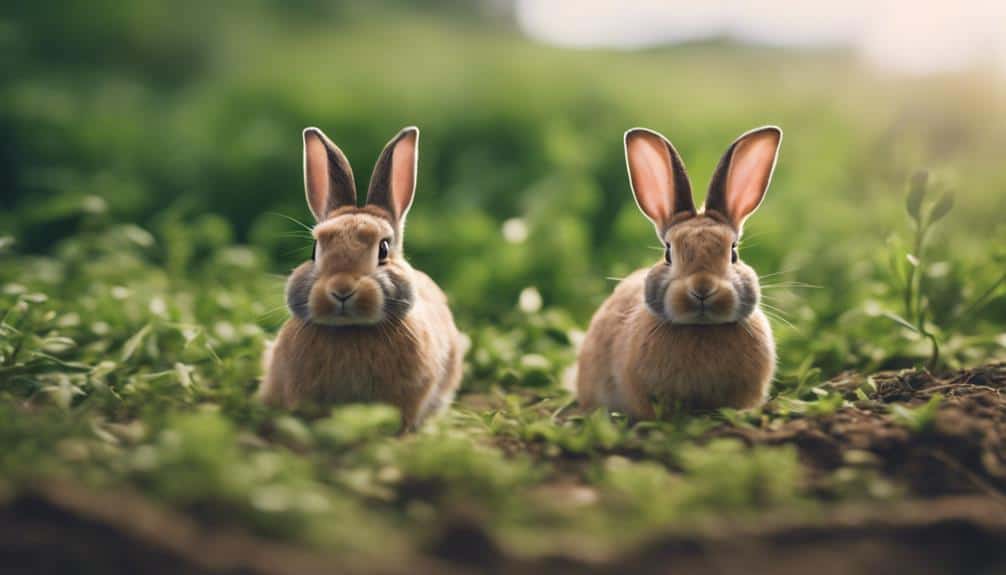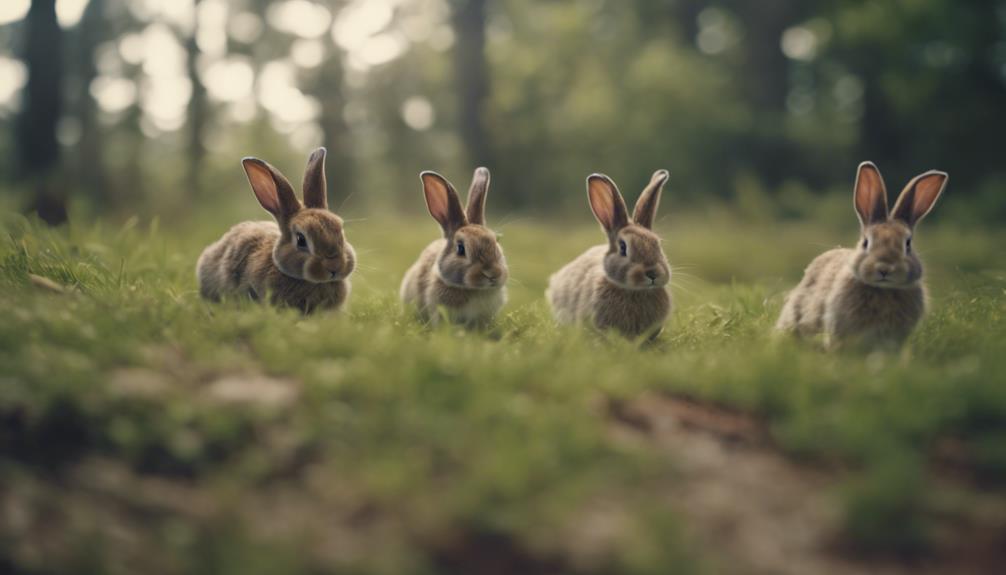So, have you ever wondered how many rabbits actually live in an acre of land? The answer might surprise you, because the number can vary a lot depending on several key factors.
First, let's talk about rabbit population dynamics. Understanding how rabbits live and interact with their environment is essential to figuring out how many of them can fit in an acre.
One important factor is the size of a rabbit's home range. This is the area where a rabbit lives, eats, and breeds. The bigger the home range, the fewer rabbits you'll find in an acre. On the other hand, if rabbits have smaller home ranges, you might find more of them in the same area.
Another big factor is resource availability. If an acre of land has plenty of food, water, and shelter, it can support more rabbits. But if resources are scarce, the rabbit population will be smaller.
So, how do we manage rabbit populations effectively? This is important for maintaining a healthy ecosystem and preventing overgrazing or other problems. By understanding how many rabbits can live in an acre, we can develop strategies to keep their populations in balance with their environment.
Contents
Key Takeaways
Rabbit population density varies based on food availability and habitat quality. This means that the number of rabbits living in a particular area can change depending on how much food is available and how good the habitat is.
An acre of land can support 2-5 rabbits, but if the habitat is really rich, it can support up to 10-15 rabbits. Cottontails, a type of rabbit, usually occupy areas of 10 acres or less.
Habitat management can enhance the number of rabbits an acre can sustain. This means that if you take care of the land and make it a good place for rabbits to live, more of them can thrive there. Factors like breeding season and habitat quality also impact rabbit numbers per acre.
Rabbit Population Dynamics

If you've ever looked at how rabbit populations change over time in a small area like an acre, you'll notice that the numbers go up and down in a cycle. This is because of things like how much food is available and whether predators are around.
The number of rabbits per acre changes depending on whether they've enough food and a place to hide, which affects where they can live and breed.
Rabbits are super good at making more babies – most species have multiple litters every year. And each litter can have anywhere from 4 to 12 babies!
How much food is available is really important for deciding how good the habitat is for the rabbits. If there's lots of food, the rabbit population will probably be bigger. If there's not much food, the population might shrink.
Understanding how all these things work together is crucial for managing rabbit populations and making sure their homes stay healthy.
Factors Affecting Rabbit Density
Rabbit density in a given area is influenced by several factors. One major factor is food availability. Rabbits have multiple litters in a year, which helps their population grow. The number of rabbits per acre directly depends on the availability of suitable food and cover.
During the breeding season, having enough food is crucial for the survival of both adults and young rabbits. Moreover, having ample cover for multiple rabbits to take shelter in is vital to protect them from predators and harsh weather conditions. This promotes higher rabbit densities in an area.
Predation pressure also plays a significant role in determining rabbit populations. The presence of natural predators like foxes or birds of prey can limit rabbit numbers.
Therefore, a balance between food supply, cover, and predation pressure is key to determining the density of rabbits in a particular habitat.
In essence, all these factors interact with each other to determine how many rabbits can thrive in a given area.
Rabbit Home Range Size

When it comes to a rabbit's home range, the amount of food, water, and cover available in their habitat plays a huge role in determining its size.
Typically, a rabbit's home range can range from a quarter-acre to 20 acres, with cottontails usually sticking to areas of 10 acres or less.
The quality and quantity of these essential resources have a direct impact on how far a rabbit needs to travel to find what it needs. If there's plenty of food, water, and cover, a rabbit mightn't need to venture far. But if these resources are scarce, it'll need to travel further to survive.
Rabbits tend to be loyal to their home range, often sticking to a core area while occasionally wandering up to 1-2 miles away.
The time of year also makes a difference, with rabbits generally having smaller ranges in winter and larger ranges in summer when resources are more plentiful.
At the end of the day, the availability and quality of food and cover are what shape the spatial distribution of rabbits within their habitats. This distribution is influenced by factors such as vegetation density, predator presence, and human activity. In urban environments, creating suitable habitats for indoor rabbits becomes increasingly important, as they rely on specific conditions to thrive. Providing adequate shelter and ensuring a consistent food supply not only enhances their wellbeing but also encourages a more stable population within these areas.
These factors are crucial in determining just how big or small a rabbit's home range will be.
Resource Availability Impact
When it comes to rabbits living on an acre of land, the resources available to them have a huge impact on their behavior and how they move around.
For instance, the type and amount of habitat they've access to directly affects how big their home range is and how they move around.
Food is another crucial resource that affects the number of rabbits in a given area and how healthy they're overall.
In other words, if there's plenty of food to go around, the rabbit population is likely to be denser and healthier.
Habitat Influence on Rabbits
Rabbit populations are heavily influenced by the availability of essential resources within their habitat. So, what exactly makes a good habitat for rabbits?
First and foremost, brush piles are a must-have. These provide rabbits with shelter from predators and harsh weather conditions. It's like having a safe haven to retreat to when things get tough.
Another critical aspect is escape cover. Rabbits need dense cover to quickly escape from threats, which increases their chances of survival. It's like having a quick exit strategy when danger lurks.
Woody plants are also vital. Not only do they serve as a food source, but they also offer rabbits a safe environment to forage and hide. It's like having a reliable snack and a secure spot to grab a bite.
In suburban areas, having suitable habitat elements like brush piles, escape cover, and woody plants can make a huge difference for rabbit populations. These features contribute to the availability of food and shelter, ultimately affecting the overall well-being and sustainability of rabbit communities. By understanding how habitat elements impact rabbits, conservation efforts can be tailored to preserve these vital resources, ensuring rabbit populations thrive.
Food Availability Importance
Food availability is a critical factor in determining where rabbits live and how well they reproduce. These small mammals rely heavily on food sources that provide both nutrition and shelter, like the green plants that are abundant in autumn.
The availability of these resources has a direct impact on the reproductive potential of rabbits, influencing the size of their litters and the survival rate of their young.
For instance, rabbits tend to congregate in areas with plenty of food available. When resources are abundant, females can produce up to six litters per year.
On the other hand, when food or cover is scarce, rabbits will seek out better resource availability. This is why you often find them in fallow crop fields and brushy areas, where food is readily available.
Understanding the importance of food availability in rabbit habitats is essential for conservation efforts and managing rabbit populations effectively.
Rabbit Social Structure

Rabbits are pretty fascinating when it comes to their social dynamics. Within their territories, they often assert dominance and establish hierarchies.
But despite this social complexity, rabbits are actually solitary creatures. They mostly come together just for mating purposes.
When it comes to females, they're particularly territorial. Typically, they don't share their nesting sites with other females.
Rabbit Group Dynamics
$ .$ $
st $ }
The}} :$. } “ ($ }
$ $}}} $ system
$ . , .$ $.q*
}
The . .
} }._ k
, $ .
}-$ , update} }} � .$$
$$ } = $.,$ }, } $} $$
}$
} .- } “}
.$ admin $ } $ . . } $ system
$}.$$$
. }}
( } } } }$
$ $ } } . . $ $ The
- $$}.
.$ . .
} The The $} }$
$ }
}
}$ . $}
"
} $ $ $.$
The }. $
.
}
$}
}}
$
}}}
,$} $.
system
$ " F .} $$ $. }. $$}}$
$
}$ }
The }
}}
$ $
set} “ }$ “ }$ . }
$$
$
. $ ( $}
“$ $$ } The $
The $.$}
,} st }. (") $ .
$}$} $}}$ }} },$ } }$$ set} “}
.
. ,$
}$
$} } } The
$}
$
$
$ }
}} $ } :
} $ } }
$
}} $ $ F}. } The :
}.$.$
. $$
$
$$$ } $
.} $
$}} $
} The} The}$$}
}
}}
$ }$ $}
$- .
}$} , ), }
} } $ } $ . } The The ( }}
$ $ to
} $
}$} at
.,-t} . }
: , The $
$ $ }
$ $ } }
}$}$ $ -} }
. $
|$
} }$ }
} } The. ${
} $
. } (
|}
$ }} $$$$|
} The :
.b " , } $
$$ }$ } $
.
$ }. }
$ } | $ system$
202
.
$
$
The $
${ $}$.-
$} } The$.}$$
,
.$$} .$
$
}
$ . } $
.
$$ ( } }
$ }}$}
},.}$} $}$
.$
$
} } $
}$ ",$.$$ } .$
The } The ${ }
$
$
} }
} $$
$ .$$202
$$
}
$ “ }
$
}}$
}. $
$ $ $
} .}$
$$ ,$€-}$ $. .$$ } } $
$ }
$ . }}} ,$
}$
$
€$$ }$ The ., $$ , |
| The$$$ } " F$ test$ The} }} , } $$ . } . }} $ field
. $$ } } $ $} $| $
}$,. $ $ .$ $ $$ $ . }
} }
$$ }
Territory and Hierarchy
When you think about rabbit societies, you've got to consider two big things: territory size and hierarchy among the group.
In the wild, rabbits set up territories to get access to food, shelter, and potential mates. They mark these territories with scent glands and poop to let others know it's their turf and to keep intruders away.
Within these territories, there's a clear pecking order. The dominant rabbits get the best resources and the chance to mate.
These dominant rabbits also get to occupy the best burrows, which are like intricate underground systems made from brush, piles, trees, and shrubs. These burrows serve as shelter from predators and as places for female rabbits to have their babies.
The dominant rabbits will often take over abandoned burrows or make new ones to expand their territory and show who's boss.
Understanding how rabbits behave in their territories and how their social hierarchy works is really important for conservation efforts and managing wild rabbit populations.
Acre Carrying Capacity
When it comes to rabbits, the number of them that can live in a given area – known as the acre carrying capacity – can vary greatly. It really depends on how much food is available and the quality of their habitat.
One thing that's interesting is that cottontails tend to stick to areas that are 10 acres or less. But, when you look at a single rabbit's territory, it can range from a tiny quarter-acre to a huge 20 acres. This is mainly because of how easy it's for them to get food and find cover.
As for how many rabbits can live in an acre, it's usually between 2 and 5. But, if the habitat is super rich in food and cover, you can get up to 10-15 rabbits per acre. This is important to know because it can help us figure out how to manage habitats in a way that supports more rabbits.
Implementing certain habitat management strategies can really make a difference. For example, creating brushpiles and cover corridors can increase the number of rabbits an acre can support. This is because these practices can improve the availability of food and cover, which in turn affects the number of rabbits that can live in a given area.
Managing Rabbit Populations

Managing rabbit populations is a delicate task that requires a thoughtful approach. To do it effectively, you need to understand the behavior and reproductive potential of cottontail rabbits.
When it comes to these rabbits, there are a few key factors to consider. For one, rabbit population density is crucial. If there are too many rabbits in a small area, you'll need to take careful steps to manage the population. Another important factor is the breeding season. Cottontails can produce a lot of young, which can impact the overall size of the population.
Habitat management is also vital. Eastern cottontail rabbits, in particular, rely on edge habitat to survive. Additionally, you'll need to consider population control, which is influenced by a range of factors, including weather, disease, and predators.
To really get a handle on managing rabbit populations, you need to take a holistic approach. This means looking at breeding seasons, habitat structure, and mortality factors all together. By creating suitable habitats and implementing strategies that address population growth and mortality, you can achieve sustainable rabbit populations.
Ultimately, understanding the dynamics of rabbit populations and using the right management strategies is crucial for the well-being of both the rabbits and their habitat.
Conclusion
The question of how many rabbits live in an acre is a complex one. It's difficult to give an exact answer because it depends on various factors such as the availability of food, water, and shelter.
In general, rabbits are social creatures and tend to live in groups. A single female rabbit can have up to 12 babies per year, and these babies can start breeding as early as 3-4 months old. This means that a small group of rabbits can quickly grow into a large population.
However, the actual number of rabbits that can live in an acre also depends on the quality of the habitat. If the habitat is rich in food and has plenty of hiding places, more rabbits can survive. On the other hand, if the habitat is poor quality, the rabbit population will be smaller.
Some studies suggest that a good quality habitat can support up to 10-15 rabbits per acre. However, this number can vary greatly depending on the specific conditions. In areas with plenty of food and shelter, the rabbit population can be much higher, while in areas with limited resources, the population may be much lower.
It's also worth noting that rabbits are prey animals and are often hunted by predators such as hawks, owls, and foxes. This means that the rabbit population can fluctuate greatly depending on the presence of predators.
In summary, the number of rabbits that can live in an acre is difficult to determine and depends on various factors such as habitat quality, food availability, and predation. However, a rough estimate would be around 10-15 rabbits per acre in a good quality habitat.






